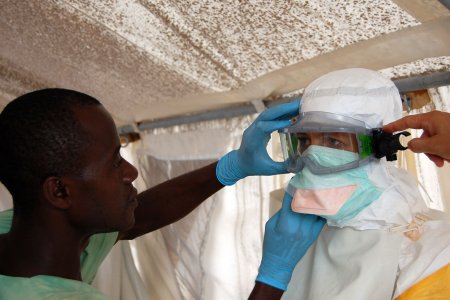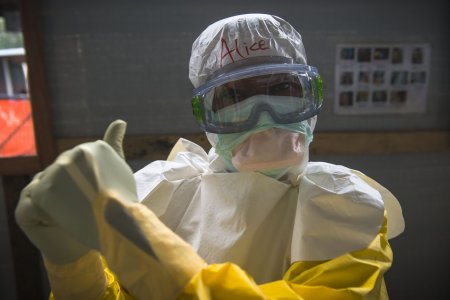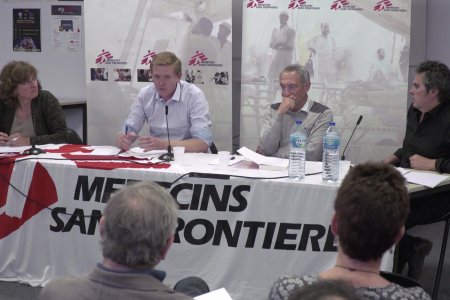
Ebola outbreak: a failure in social mobilisation
Jean-Hervé Bradol & Elba Rahmouni
On August 1st 2018, the Democratic Republic of Congo’s health authorities declared the country’s tenth outbreak of Ebola virus disease (EVD), this time in North Kivu province. Just over a year later, this outbreak is still ongoing, with several dozen new cases reported each week. In the space of 12 months, 3000 people contracted the disease and 2000 of them have since died. This latest outbreak can be seen as a failure at two levels: first, it is already the second biggest EVE outbreak ever recorded, and second, two out of three patients have died. What are the reasons for this failure? What operational strategies should we develop in response?
Interview with Jean-Hervé Bradol, Director of studies at CRASH, by Elba Rahmouni.
MSF is participating in a joint Ministry of Health/WHO/NGO Ebola response in DRC, known as the Strategic Response Plan or SRP. Can you tell us something about the SRP’s “contact tracing” strategy?
As in previous outbreaks, our current Ebola response is based on identifying new cases, dead or alive, as quickly as possible, but also everyone who has been in contact with them. The aim is to give these contacts a molecular diagnostic test, vaccinate them and then monitor them for 21 days to see whether they develop the disease. Ideally, if clinical signs appear and the test results are positive, they will be immediately quarantined to prevent them from transmitting the virus to anyone else in this symptomatic phase during which they are contagious.
This “case monitoring” strategy is effective in a closed environment such as a refugee camp, but very difficult to implement in an open environment, especially in large towns with a high population density - of which there are many in North Kivu and Ituri provinces. Today about a third of cases are slipping through the net and have not been monitored before arriving at an Ebola Treatment Center (ETC). Furthermore, a large proportion of the cases are admitted to an ETC at a late stage, several days after the appearance of symptoms. By this time, there is already organ damage and treatments are less likely to prevent a fatal outcome.
How do you explain the fact that many people who have been in contact with confirmed cases are not being monitoring by the SRP teams or arrive at the ETCs when the disease has already reached an advanced stage?
If we are to control the epidemic, the population must understand and adhere to the SRP’s activities. But there is nothing attractive about the current offer being made to patients by the health authorities. Why rush to a treatment center when you only have one in two chances of getting out alive? Isn’t it better to stay at home surrounded by your family if going to an ETC doesn’t really improve your chances of survival? For most people, the epidemic response plan doesn’t offer them anything worth having.
To sum up, putting contagious people in quarantine to limit the spread of the disease makes sense in theory, but in practice the SRP teams have to chase after patients and their entourage without having anything of real benefit to offer them. Some patients are afraid; they run away and hide. They steer ll clear of the health system.
Apart from these difficulties reconciling public health requirements and people's individual motivations, are there any other reasons for the population’s reaction to the SRP’s activities?
There’s the tense political context, of course. North Kivu is a politically unstable region that has seen fighting between armed groups for decades. This complicated political environment fosters anxiety and distrust among the population. Security issues have also made the SRP’s activities more difficult to implement. The situation on the ground is one of insecurity, rumours and attacks on ETCs and against members of the epidemic response teams.
The economics of the response are another reason for the divide between the SRP and the population. For health actors, an epidemic is primarily a health disaster. For families who are no longer able to work, it means paying for transport to treatment centers, meeting the heavy cost of burials, etc. and so is often also an economic disaster. Many people resent not benefiting more directly from the money in circulation for managing the epidemic and believe that much of it is being misappropriated by the authorities and their agents on the ground. They want this money, or at least part of it, to be of direct benefit to the inhabitants of North Kivu. At MSF, we are considering the idea of providing patients and their families with some form of financial assistance. But this is a difficult measure to introduce, as the idea of paying patients and their families to adhere to treatment runs counter to traditional health management practices.
According to the Ministry of Health, around 100 million euros are being spent on the Ebola response. This extraordinary amount of money (in itself and for “just” 3000 cases) On the issue of the scale of the mobilisation for Ebola, see CRASH’s analysis in the blog : Ebola in the DRC: between operational trial and error and scientific uncertainty.raises important questions about distribution, transparency and management which the SRP needs to address. In complex contexts such as this, there are always two pitfalls for those in charge of the response to avoid: hindering it by not providing sufficient funding and undermining it through the poor use (waste and misappropriation) of available resources.
Doesn’t a successful response to a health disaster largely depend on a successful social mobilisation?
A key indicator of the success of a response is when care providers and care receivers are seen to adopt certain behaviours in two areas: treatment and prevention. Our operations consist in providing the means, such as antiretrovirals, vaccines, the organisation of care, etc., while asking users and personnel to rapidly adopt new behaviours with the dual purpose of saving patients and reducing the number of new cases.
Furthermore, contrary to a widespread feeling of omnipotence among institutions and staff, it is often not possible to reduce the duration of an outbreak though medical and health action. What we are able to achieve depends to a large extent on the quality of social and political mobilisation.
A recent clinical trial would seem to confirm the effectiveness of certain new treatments. Do you think that these promising findings will help reconcile the SRP and its users?
Yes, the availability of antibody-based treatment in the ETCs should help attract patients. According to the PALM clinical trial conducted by the NIH, two antibody-based treatments, mAb114 and REGN-EB3, significantly reduce case fatality ratios in people with EVD29% and 34% of mortality respectively, whereas it is between 60% and 67 % for people without treatment.. When administered early, these new treatments can invert the proportion of deaths and recoveries. We should see a switch from two deaths for every one person cured to two people cured for every one death. And when patients go to an ETC less than 48 hours after the onset of clinical symptoms, the case fatality rate declines to around 10%These antibody-based treatments could also be used as a matter of course with the entourage of a confirmed case. These people living in close proximity to a carrier of the virus and thus very likely to contract the disease could thus be treated as early as possible, at home, before the clinical signs appear. For these cases, we must find the best way of associating antibody perfusions and vaccinations.. This is the kind of information we should be giving people to show them that things are changing.
The new means available to the SRP teams are reasons for optimism: vaccination is proving effective, there are now two very promising treatments and the organisation of care has improved, especially since ALIMA developed the Cube - quarantine unit with transparent walls and external arm entries which allows medical teams to maintain a caregiver/receiver relationship and facilitates intensive care proceduresVideo Ebola in the DRC: ALIMA opens a treatment center equipped with CUBE.. Clinical staffs are reporting a much higher recovery rate, even among pregnant women and children.
To improve social mobilisation for the Ebola response, what other priorities should we pursue?
For more than twenty years, the response to EVD outbreaks has been based on six pillars1° monitor the progression of the disease, 2° inform the population, 3° set up ETCs to isolate and manage the patients, 4° identify and monitor people who have been in contact with a confirmed case, 5° ensure safe burials, 6° protect the other health centers.. On the plus side, this model covers all the different dimensions of the response, but on the minus side it fragments it, each actor having a specific and separate mission, and overlooks the importance of local-level coordination which would allow a comprehensive response for each patient and in each disease hotspot. What’s more, despite the new tools available, notably the drugs and vaccines, the SRP teams have not yet changed the way they work. They treat everyone the same way when in fact we should be looking into ways of adapting to each patient, i.e. giving this person post-exposure prophylaxis treatment, vaccinating that one, providing home-based monitoring for another, bringing this one into the center every day because he’s more likely to develop the disease, or telling that one, who has understood the situation, to come in without delay if he develops symptoms. Lastly, I think it’s also important to decentralise the response and do more outreach work in the districts where the patients live so we can reach more people. MSF is taking over the Beni ETC from ALIMA, but we’ll be maintaining our presence in several of the town’s districts.
To sum up, by coordinating the different aspects of the SRP more effectively, adopting an approach specific to each patient and decentralising the response, we should improve relations between the patients, their families and the medical teams.
The SAGE (Strategic Advisory Group of Experts on Immunization) is a group of experts mandated by WHO to advise the organisation on vaccination issues. In light of the latest SAGE recommendations published last May, the government is now planning to extend vaccination coverage. Will easier access to vaccination change things?
We know that 90% of the people offered vaccination give their consent to it. Extending vaccination should therefore help reconcile inhabitants and SRP teams. Yet despite the stated intention to vaccinate more widely, the experimental rVSV-ZEBOV-GP vaccine being manufactured by the American laboratory MerckA vaccine that proved effective in a clinical trial carried out in West Africa in 2015.is still only being administered to a handful of the region’s inhabitants. Only the most exposed members of the SRP team Vaccination should be used to protect caregivers and all overexposed personnel. This is an important point at a time when more than 150 SRP staff members have already contracted the disease. Today, one third of health workers are still not vaccinated.or family members living in close proximity to a confirmed case have access to this vaccine.
A study of channels of transmission shows that the disease is most commonly passed on by a family member. Therefore, large-scale vaccination will not necessarily curb the epidemic (and might even lead to unnecessary vaccination). However, given the persistent occurrence of new cases in certain areas, we should perhaps consider broader use of the vaccine by geographical zone.
If we’re considering increasing the use of vaccination, a key issue will be procurement and the quantity of vaccines available. But we don’t yet know exactly how many doses of rVSV-ZEBOV-GP vaccine will be required. So, as we are in dark here, we’ll need to have several sources of supply. Meanwhile, a second vaccine is currently being developed by Janssen, a Belgian subsidiary of the American laboratory, Johnson & Johnson. Bearing in mind the need to prepare for future EVD outbreaks, we should take advantage of the conditions created by the current outbreak to run a clinical trial of the Janssen vaccine.
Given the time required for scientific research on the one hand and the obligation to respond rapidly to a health and social emergency on the other, how do you bring these two dimensions together in your work for MSF?
Operations and scientific research complement each other but have different timeframes. It’s impossible to control all the parameters and there are also clear limits to our knowledge. As a result, there are always risks involved in the action we take, but we adjust this action regularly on the basis of new knowledge. For example, I was thinking about extending the use of antibody therapies to people strongly suspected of having contracted the Ebola before the disease actually develops. This idea has emerged from our action as we know that the earlier we treat people, the better chance they have of survival. But there haven’t been any scientific studies on this as yet. There is always an element of uncertainty in what we do and we accept that. But the uncertainty of our activities and scientific experimentation (when we test a vaccine, for example) must be kept in check through dialogue with the patient and his/her family when seeking medical consent, and through public debate with civil society.
To conclude, have we learned anything new from this latest Ebola outbreak?
In my opinion, the two outbreaks that have taught responders the most are the 1976 outbreak in Zaire (discovery of the disease and the virus responsible for it) and the current outbreak in North Kivu. The epidemic in 2013-2016 was exceptional because of its geographic spread (Guinea, Liberia, Sierra Leone, Nigeria, Mali and Senegal in Africa, Spain and the UK in Europe and the USA) and the number of cases, almost ten times more than in the outbreak currently underway25 515 cases, 11 020 deaths, or a 40% case fatality rate.. It also enabled us to test the first vaccine.
But today, we are seeing an unprecedented mobilisation of resources. We can see that medical research has been fruitful, with compassionate protocols for the use of treatments outside the recommendations of accreditation agencies, two vaccines, one of which was tested during an epidemic outbreak, two antibody-based treatments that look set to invert survival proportions, better organisation of care in the ETCs, the introduction of intensive care protocols and a rapid diagnostic test (RDT) coming soon.
By combining all these resources, we should obtain much better results in terms of case fatality rates, (the proportion of deaths among patients) and incidence (number of new cases). But to get the best out of these biomedical tools, they need to be apposed and organised intelligently in an approach that can be clearly perceived as beneficial by patients and their entourage.
To cite this content :
Jean-Hervé Bradol, Elba Rahmouni, “Ebola outbreak: a failure in social mobilisation”, 10 septembre 2019, URL : https://msf-crash.org/en/blog/medicine-and-public-health/ebola-outbreak-failure-social-mobilisation
If you would like to comment on this article, you can find us on social media or contact us here:
Contribute





Add new comment